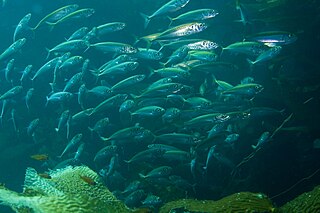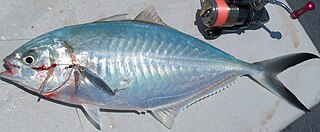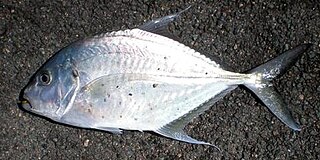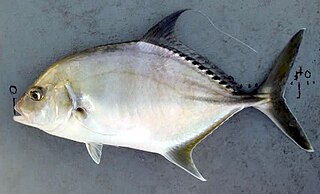Horse mackerel is a vague vernacular term for a range of species of fish throughout the English-speaking world. It is commonly applied to pelagic fishes, especially of the Carangidae family, most commonly those of the genera Trachurus or Caranx. Species known as "horse mackerel" in one English dialect or another include:

The Carangidae are a family of ray-finned fish that includes the jacks, pompanos, jack mackerels, runners, trevallies, and scads. It is the largest of the six families included within the order Carangiformes. Some authorities classify it as the only family within that order but molecular and anatomical studies indicate that there is a close relationship between this family and the five former Perciform families which make up the Carangiformes.

The Pacific jack mackerel, also known as the Californian jack mackerel or simply jack mackerel, is an abundant species of pelagic marine fish in the jack family, Carangidae. It is distributed along the western coast of North America, ranging from Alaska in the north to the Gulf of California in the south, inhabiting both offshore and inshore environments. The Pacific jack mackerel is a moderately large fish, growing to a maximum recorded length of 81 cm, although commonly seen below 55 cm. It is very similar in appearance to other members of its genus, Trachurus, especially T. murphyi, which was once thought to be a subspecies of T. symmetricus, and inhabits waters further south. Pacific jack mackerel travel in large schools, ranging up to 600 miles offshore and to depths of 400 m, generally moving through the upper part of the water column.

The bigeye trevally, also known as the bigeye jack, great trevally, six-banded trevally and dusky jack, is a species of widespread large marine fish classified in the jack family Carangidae. The bigeye trevally is distributed throughout the tropical waters of the Indian and Pacific Oceans, ranging from South Africa in the west to California and Ecuador in the east, including Australia to the south and Japan in the north. The bigeye trevally is best distinguished by its colouration, having a dark second dorsal fin with a white tip on the lobe, and also possessing a small dark spot on the operculum. Other more detailed anatomical features also set the species apart from other members of Caranx. The species is known to grow to a length of 120 cm and 18 kg.

The orange-spotted trevally, Carangoides bajad is a species of inshore marine fish in the jack family, Carangidae. The species is fairly common in tropical to subtropical waters of the Indo-Pacific, ranging from Madagascar in the west to Japan in the east, typically inhabiting inshore reefs. The species has characteristic orange-yellow spots on its sides, although counts of fin rays and scutes are needed to distinguish it from related species with similar colouring. Orange-spotted trevallies are powerful predators, taking a variety of small fish, nekton, and crustaceans, and reach sexual maturity around 25 cm long. It is a moderately large fish, reaching a maximum known length of 55 cm. The species is occasionally taken by fishermen throughout its range, and is generally considered to be bycatch. The exception to this is in the southern Persian Gulf, where it makes up a large proportion of the fishery.

The shrimp scad, is a species of widespread tropical marine fish of the jack family, Carangidae. The shrimp scad is widely distributed in the tropical and subtropical western Indian Ocean and areas of the eastern Pacific Ocean, ranging from South Africa in the west to Hawaii in the east, including Japan and Australia to the north and south. The species is commonly found on inshore reefs and sandy substrates. It has the common body profile of a scad, and may be difficult to differentiate from others in the genus Alepes. It is one of the larger scads, growing to 40 cm, but often is encountered at much smaller sizes. The shrimp scad often forms large schools, and is carnivorous, consuming a variety of crustaceans and small fish. It is of moderate importance to fisheries throughout its range.

The razorbelly scad is a small species of tropical marine fish in the jack family, Carangidae. The species inhabits coastal waters in the Indo-Pacific, from Pakistan in the west to Japan and Australia in the east, often found over reefs. The razorbelly scad has a complex taxonomic history, and even recently has had its position in the genus Alepes challenged, but appears to be stable after a molecular phylogeny study supported its placement in Alepes. It is very similar to other scads in the same genus, but is readily identified by its unique teeth. Razorbelly scad are predatory fish, taking a variety of crustaceans and shrimps, and show a change in feeding intensity over the year. Reproduction and development have been extensively studied in India, where spawning occurs in a single event from January to September. The species is commonly taken in tropical fisheries, where it is marketed fresh or dried.

Alepes is a genus containing five extant species of tropical marine fishes in the jack family, Carangidae. They are commonly known as scads, a term applied to many genera of carangid fishes. Their body form, however, differs from these other scads by being much more ovate in shape, more similar to the larger jacks taken as game fish, although scads are generally much smaller. They are found in coastal waters throughout the Indo-West Pacific region.

The herring scad, is a common species of tropical marine fish in the jack family Carangidae. The species inhabits the surface waters of coastal regions throughout the Indo-West Pacific region, feeding on a variety of crustaceans and small fishes. It is the largest fish of the scad genus Alepes, growing to a recorded length of 56 cm. The herring scad is identified among the genus Alepes by its more numerous and smaller scutes and the number of gill rakers on the first arch. It is of minor importance to fisheries throughout its range.

The yellowtail scad, is an abundant species of small inshore marine fish of the jack family, Carangidae. The species is widespread in the Indo-Pacific region from east Africa in the west to Hawaii in the east, extending north to Japan and south to Australia. The yellowtail scad is the only member of the monotypic genus Atule and is distinguished from similar species by a well-developed adipose eyelid and finlet-like extensions of the last rays of the dorsal and anal fins. It inhabits coastal areas such as bays and coral reefs, preying on small fishes and crustaceans. Spawning has been well studied in Hawaii, where fish enter bays to spawn, releasing up to 161,000 eggs each between March and October. The yellowtail scad is an important component of fisheries throughout its range, taken by a number of netting and hook-and-line methods. It is a prized food fish in some regions and is cooked or preserved by a variety of methods.

The longnose trevally, also known as the tea-leaf trevally, club-nosed trevally, grunting trevally or dusky trevally, is a species of inshore marine fish in the jack family, Carangidae. The species is distributed throughout the tropical and subtropical waters of the Indian and west Pacific Oceans from South Africa to New Zealand and Japan, inhabiting coastal waters, especially reefs, to a depth of 90 m. The longnose trevally is distinguished from similar species by a combination of a scaleless breast and the number of gill rakers and fin rays. It is a moderately large fish, growing to a maximum known length of 72 cm and 4.35 kg. The longnose trevally is a predatory fish, consuming small fish, crustaceans and molluscs. The species is of minor commercial importance throughout its range, and is considered to be a good table fish.

Decapterus is a genus of marine fishes of jack family, Carangidae, commonly known as mackerel scads, round scads, or horse mackerel. They are found throughout the world.

The green jack, also known as the horse jack, is an abundant species of coastal marine fish in the jack family Carangidae. The species is distributed in the eastern Pacific Ocean along the American coastline from Santa Cruz Island off California in the north to Peru in the south, as well as a number of islands including the Galapagos and recently, Hawaii. The green jack is distinguished from other similar carangid species by a number of features including gill raker and lateral line scale counts, and the presence of an adipose eyelid. It is a moderately large species, growing to at least 55 cm in length and 2.81 kg, although unconfirmed reports suggest a much larger maximum size. It lives in a wide range of continental shelf environments including estuaries, bays, reefs and offshore seamounts, living both pelagically and demersally. The green jack is a predatory species, preying on a variety of fish, crustaceans and cephalopods, as well as zooplankton. Most fish are sexually mature by the time they attain 38 cm, with spawning occurring between May and October. The species is of high importance to fisheries throughout its range, caught by pelagic trawls, a variety of netting methods and hook and line. The green jack is also of interest to anglers, taken by bait and lures, although is considered to only be fair in eating quality.

The bumpnose trevally, also known as the bumpnose kingfish or onion kingfish, is a species of relatively small inshore marine fish classified in the jack family Carangidae. The bumpnose trevally is fairly common in the tropical and subtropical waters of the Indo-west Pacific region, ranging from South Africa in the west to Japan and Samoa in the east. It is a small species by carangid standards, reaching a maximum known length of 32 cm, and can be distinguished from the similarly shaped Carangoides armatus by a distinct 'bump' on the snout, which gives the fish its common name. The species inhabits coastal waters, often living along bays and beaches, where it takes shrimp, small crabs, and juvenile fish as prey. The bumpnose trevally is of minor importance to fisheries throughout its range, taken by hook and line, trawls, and seine nets. It is also of minor importance to anglers, taken by baits from beaches and piers, and is considered a modest table fish.

The coachwhip trevally, also known as the oblong trevally or oblique-banded trevally, is a species of inshore marine fish classified in the jack family Carangidae. The coachwhip trevally is distributed through the Indo-west Pacific region, ranging from South Africa in the west to Fiji and Japan in the east. It is a moderately large fish, growing to a known maximum length of 46 cm and can be distinguished from similar species by an array of detailed morphological features including dentition, fin ray counts and scale patterns. The coachwhip trevally inhabits coastal waters throughout its range, known to prefer estuarine waters in a number of localities. Nothing is known of its diet or reproductive biology, and is of little importance to fisheries, occasionally taken as bycatch in trawl and hook and line fisheries.

The blacktip trevally, also known as the blacktip kingfish or yellowtail kingfish, is a species of large marine fish classified in the jack family Carangidae. The blacktip trevally is distributed throughout the tropical to subtropical Indian and West Pacific Oceans, ranging from South Africa in the west to Fiji, Japan and northern Australia in the east. It inhabits coastal waters throughout its range, preferring moderately deep clear waters over rocky and coral reefs. The blacktip trevally is easily distinguished by its yellow fins and a dark upper caudal fin lobe which gives the species its common name, as well as a host of other anatomical features. The species is known to reach a maximum size of 1 m. It is a benthopelagic predator, commonly forming small shoals where it takes a variety of fishes, cephalopods and crustaceans as prey. Little is known of reproduction in the species, and spawning is assumed to take place in more tropical regions of its range, with juveniles known to inhabit bays and large estuaries. Blacktip trevally are often caught using hook and line and various nets in commercial fisheries although don't make up a large part of the market. They are also popular with anglers due to their fighting ability and decent table qualities.

The false scad, also known as the spotfin scad, ten-finned horse mackerel and yellow horse mackerel, is a species of medium-sized marine fish classified in the jack family Carangidae. The false scad is distributed throughout the tropical and temperate waters of the eastern Atlantic Ocean from Namibia in the south to Spain and throughout most of the Mediterranean in the north. The species has an atypical body form compared to other species of Caranx, and can be distinguished from these on its elongate 'scad-like' body shape alone. Distinguishing the species from members of Decapterus and Trachurus is more difficult, requiring detailed anatomical analysis. The false scad is known to grow to a length of 60 cm and a weight of 1 kg. The species lives both pelagically and demersally in continental shelf waters, ranging from depths of 15 to 200 m. It is a predatory fish, taking small fishes, crustaceans including euphausiids and shrimps, and cephalopods as its main prey, with significant dietary shifts as it ages. The false scad reaches sexual maturity at 2 years of age, with spawning occurring between April and July in shallow inshore waters, where the juveniles remain. The species is of major importance to fisheries throughout its range, but particularly from Morocco to Senegal, with annual catches ranging from 500 to 19000 t. The species is caught using trawls, seine nets and gill nets and sold fresh, frozen or salted.

The tille trevally, also known as the tille kingfish, is a species of large marine fish classified in the jack family, Carangidae. The tille trevally is distributed through the tropical and subtropical waters of the Indo-Pacific region, ranging from South Africa in the west to Fiji, Japan and Australia in the east. The species is best distinguished by its rounded, strongly convex anterior profile, with other detailed anatomical features also useful. The tille trevally reaches a maximum length of 80 cm and a weight of 7.2 kg. It is predominantly an inshore species, inhabiting coastal reef and lagoon environments, although has been recorded on deep offshore seamounts. It is a predatory fish, taking various species of fish and crustaceans as prey, with little known of its reproductive cycle. It is of minor importance to fisheries throughout its range, taken by hook and line, gill nets and purse seines. The tille trevally is also considered a good game fish, and an excellent table fish. The species acquired its scientific and common names from a local name used by Pondicherry fishermen, koton tille, which Georges Cuvier then used when he named the species in 1833.

The fringefin trevally, also called fringe-finned trevally, round-finned trevally or reef herring, is a species of inshore marine fish classified in the jack and horse mackerel family Carangidae. A relatively small fish, the fringefin trevally is known to reach 40 cm (16 in), but is mostly encountered at lengths less than 25 cm (9.8 in). The fringefin trevally has an ovate body, with distinctive orange-yellow fins and a black opercular spot. The dental patterns of the species distinguish it from the closely related scads of the genus Alepes. Males have characteristic elongated dorsal and anal fins which produce a series of trailing filaments. The fringefin trevally is restricted to the waters of the Indo-Pacific, ranging from northern Australia to Papua New Guinea and eastern Indonesia. An inshore species, it is found in coastal and estuarine environments and exhibits daily and seasonal movements. The fringefin trevally is predatory, taking crustaceans as prey. The species is often taken as bycatch in prawn trawls and occasionally taken by anglers.

The longrakered trevally, also known as the cale cale trevally and heavyjawed kingfish, is a species of marine fish in the jack and horse mackerel family Carangidae. The longrakered trevally is distributed throughout the tropical and subtropical waters of the Indian and west Pacific Oceans, from Mozambique and Madagascar in the west, to Japan and northern Australia in the east. A large species growing to a recorded length of 1 m, the longrakered trevally is distinguished by is protruding lower jaw, elongated gill rakers and lack of villiform teeth on its tongue. It is an inshore species, restricted to coastal and estuarine regions, where it preys on fishes and crustaceans. Little is known of the species reproductive cycle or growth. The longrakered trevally is of minor importance to fisheries and is often taken as bycatch in finfish and prawn trawls, as well as by recreational fishermen.






















